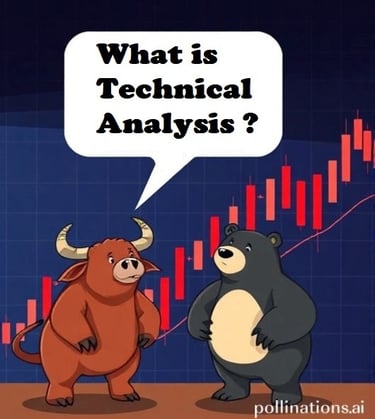Technical Analysis

What is Technical Analysis?
Technical analysis is essentially the study of market psychology through the use of charts to identify future price trends. Imagine trying to predict your favorite TV show's plot by analyzing past episodes' patterns and cliffhangers. In a similar vein, technical analysts use historical price and volume data to forecast future market movements. The primary tools of the trade are charts and indicators, which help spot patterns and trends that might suggest where the market is headed next.
How Supply and Demand Control the Stock Price
At its core, the price of a stock is determined by supply and demand. When more people want to buy a stock (demand) than sell it (supply), the price goes up. Conversely, if more people want to sell a stock than buy it, the price goes down. Think of it like bidding on an item at an auction – the more bidders (buyers) there are, the higher the price goes. Technical analysts look at these supply and demand dynamics through charts to make predictions about future price movements.
Bridging the Gap: Technical vs. Fundamental Analysis
Technical analysis bridges the gap between understanding how stock prices evolve and fundamental analysis, which looks at a company's performance. While fundamental analysis focuses on a company's financial health, management, and market position, technical analysis uses charts to identify patterns and trends that might not be immediately evident from the company's fundamentals. It's like combining a doctor's diagnosis with a patient's medical history to get a more comprehensive view of their health.
Evolution of Technical Analysis
The history of technical analysis is as colorful as a well-designed candlestick chart. It all began in the 17th century with Japanese rice traders, who developed the concept of candlestick charting to track rice prices. Fast forward to the 20th century, and Charles Dow, co-founder of the Wall Street Journal, laid the foundation for modern technical analysis with his Dow Theory. From these humble beginnings, technical analysis has evolved into a sophisticated field with numerous tools and techniques.
The Role of Automated Trading Systems (Trading Robots)
Today, we even have trading robots and automated systems, thanks to advances in technology. These robots are programmed to analyze charts and execute trades based on predefined criteria. Think of them as your personal financial assistants, tirelessly working around the clock to help you make informed trading decisions. It's like having a superhero sidekick, but instead of fighting crime, they're fighting for your financial gains.
Criticisms of Technical Analysis
The Self-Fulfilling Prophecy
Despite its widespread use, technical analysis has its fair share of critics. One major criticism is the concept of the "self-fulfilling prophecy." The idea here is that if enough traders believe in a particular pattern or trend, their actions can cause the market to move in that direction. It's like everyone in a crowded room shouting "fire!" and causing a panic, even if there's no real danger. In other words, the mere belief in certain patterns can create market movements, making the predictions come true.
Even if most technicians did agree on a market forecast, they wouldn't all jump in at the same time and in the same way. Some would try to anticipate the chart signal and get in early, others would buy the breakout from a given pattern or indicator, and still others would wait for the pullback after the breakout before making a move. You've got aggressive traders and conservative ones, those who love their stop orders and those who swear by market orders. Some are in it for the long haul, while others are just day trading. So, the idea that all technicians would act simultaneously is pretty far-fetched. For any forecasting technique to become so popular that it begins to influence events, it would have to be pretty darn accurate!
Another common critique is whether the past can truly predict the future. Skeptics argue that market conditions are constantly changing, and relying on historical data might not always provide accurate forecasts. It's like trying to navigate a modern city using a map from the 1800s – you might find some familiar landmarks, but the overall landscape has changed dramatically.
Can the Past Predict the Future?
So, can the past really predict the future? The answer is both yes and no. While historical data can provide valuable insights and help identify trends, it's essential to remember that the market is influenced by a multitude of factors, including economic events, geopolitical developments, and investor sentiment. These factors can create new patterns or disrupt existing ones, making the market unpredictable at times.
Think of it like weather forecasting. Meteorologists use historical weather data to predict future conditions, but unexpected events can still throw their forecasts off. Similarly, technical analysis can provide valuable information, but it's not foolproof. It's always wise to combine technical analysis with other forms of research, such as fundamental analysis, to make well-rounded trading decisions.
The Random Walk Theory
Enter the Random Walk Theory, which suggests that stock prices move randomly and cannot be predicted accurately. According to this theory, the market's movements are akin to a drunkard's walk – unpredictable and chaotic. Proponents of the Random Walk Theory argue that any attempt to forecast future price movements based on past data is futile. It's like trying to predict the next move of a cat on a sugar high – good luck with that!
However, the idea that markets are random is totally laughed off by the technical community. If markets were truly random, no forecasting method would work. Imagine looking at a Jackson Pollock painting—it might look like a mess of random splatters to most of us, but to an art critic, every splash of paint has a purpose and tells a story. Similarly, what might seem like chaotic squiggles on a stock chart to the untrained eye can reveal insightful patterns to a skilled analyst. The workings of the markets may appear random to those who have not taken the time to study the rules of market behavior. The illusion of randomness gradually disappears as the skill of chart reading improves.
Despite these criticisms, many traders and analysts swear by technical analysis. They argue that human emotions, such as fear and greed, drive market movements, and these emotions tend to repeat themselves in recognizable patterns. By identifying these patterns, traders can make more informed decisions and potentially gain an edge in the market.
Tackling the Tough Spots: Challenges in Technical Analysis
Technical Analysis and IPOs
One limitation of technical analysis is that it can't be applied to initial public offerings (IPOs). Since IPOs are new to the market, there isn't any historical price data to analyze. It's like trying to predict a movie's plot from a teaser trailer – there's just not enough information to go on. In such cases, traders often rely more on fundamental analysis and market sentiment to make decisions.
Influence of Major Players
The market isn't just a playground for individual traders; it's heavily influenced by big money players like institutions, banks, and hedge funds. These entities can move markets with their large trades, and their actions can create trends that technical analysts then interpret. It's like being at a concert where the crowd's reaction can be swayed by a few enthusiastic fans up front. Understanding the role of these major players can provide valuable context to the patterns and trends identified through technical analysis.
Limitations When Few Firms Dominate
Another scenario where technical analysis may fall short is when one or two firms dominate the market. In such cases, the price movements of these firms can significantly impact the overall market, making it harder to rely on technical patterns alone. It's like trying to predict the outcome of a game where one player holds all the cards. In such scenarios, a combined approach with fundamental analysis might offer better insights.
Final Thoughts
Technical analysis is like a fascinating puzzle, blending art and science to help traders navigate the financial markets. While it's not a guaranteed way to riches, it can provide valuable insights and improve your trading decisions. Whether you're a seasoned trader or just starting, understanding technical analysis can be a valuable addition to your financial toolkit.
Remember, while the past can offer clues about the future, it's essential to stay adaptable and consider the ever-changing market landscape. Happy charting, and may the trends be ever in your favor! 📈🕵️♂️


